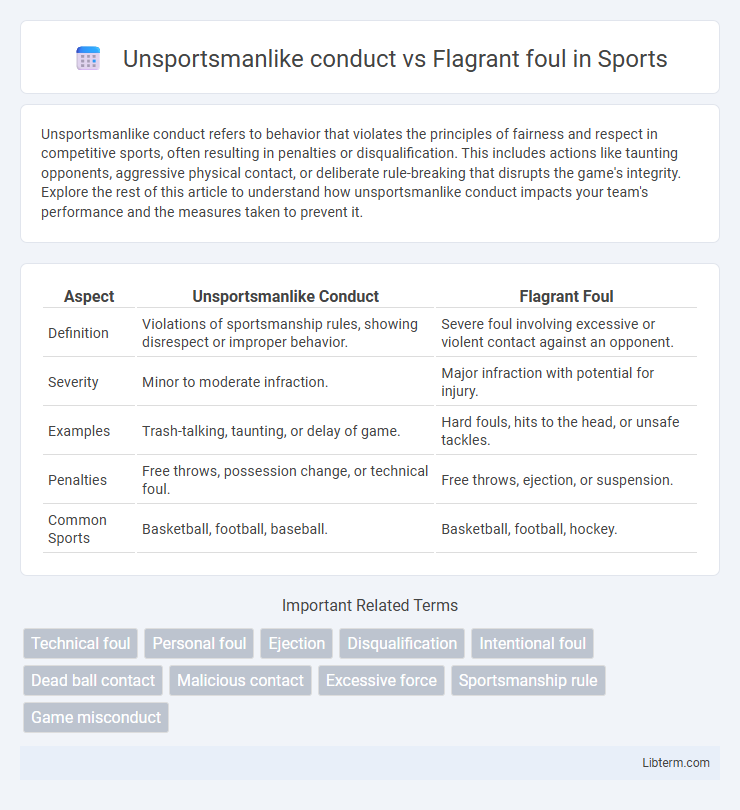Unsportsmanlike conduct refers to behavior that violates the principles of fairness and respect in competitive sports, often resulting in penalties or disqualification. This includes actions like taunting opponents, aggressive physical contact, or deliberate rule-breaking that disrupts the game's integrity. Explore the rest of this article to understand how unsportsmanlike conduct impacts your team's performance and the measures taken to prevent it.
Table of Comparison
| Aspect | Unsportsmanlike Conduct | Flagrant Foul |
|---|---|---|
| Definition | Violations of sportsmanship rules, showing disrespect or improper behavior. | Severe foul involving excessive or violent contact against an opponent. |
| Severity | Minor to moderate infraction. | Major infraction with potential for injury. |
| Examples | Trash-talking, taunting, or delay of game. | Hard fouls, hits to the head, or unsafe tackles. |
| Penalties | Free throws, possession change, or technical foul. | Free throws, ejection, or suspension. |
| Common Sports | Basketball, football, baseball. | Basketball, football, hockey. |
Defining Unsportsmanlike Conduct
Unsportsmanlike conduct refers to behavior during a game that violates the spirit of fair play, such as taunting, excessive arguing with officials, or disrespecting opponents. Unlike a flagrant foul, which involves aggressive or dangerous physical contact, unsportsmanlike conduct focuses more on inappropriate verbal or non-physical actions. This type of misconduct can result in penalties like technical fouls or ejections to maintain respect and order within the sport.
What Constitutes a Flagrant Foul
A flagrant foul in basketball constitutes a severe and intentional act of physical contact that risks injury to an opponent, such as excessive force or violent behavior during play. Unlike unsportsmanlike conduct, which involves disrespectful or inappropriate behavior not necessarily involving physical harm, a flagrant foul specifically targets player safety with aggressive actions like striking, punching, or dangerous tackles. Basketball leagues enforce strict penalties for flagrant fouls, including immediate ejection and potential suspensions, emphasizing the emphasis on protecting athletes from harmful physical conduct.
Key Differences Between Unsportsmanlike Conduct and Flagrant Foul
Unsportsmanlike conduct typically involves behavior that violates the spirit of fair play, such as taunting or intentionally delaying the game, and often results in technical fouls. In contrast, a flagrant foul constitutes excessive or violent contact that poses a risk of injury to an opponent and is categorized into Flagrant 1 or Flagrant 2 depending on severity. The key difference lies in intent and physicality: unsportsmanlike conduct is primarily about poor sportsmanship without direct physical harm, while flagrant fouls involve harmful or aggressive physical actions.
Intent and Severity in Rule Interpretation
Unsportsmanlike conduct involves actions or language that show disrespect or poor sportsmanship, often deemed intentional but generally less severe in physicality compared to flagrant fouls. Flagrant fouls are aggressive, violent fouls with an intent to harm or severely impact an opponent, resulting in harsher penalties due to their greater severity and potential for injury. Rule interpretation emphasizes the intent behind the act and its severity, distinguishing unsportsmanlike conduct as conduct-related violations and flagrant fouls as dangerous physical infractions warranting immediate ejection or fines.
Common Examples in Professional Sports
Unsportsmanlike conduct in professional sports often includes actions like taunting opponents, excessive arguing with referees, or deliberate delays of game, which undermine the spirit of fair play. Flagrant fouls typically involve violent or aggressive physical contact, such as intentional elbowing in basketball, spear tackles in football, or high tackles in rugby, posing injury risks to opponents. Both violations result in penalties, but flagrant fouls usually carry harsher consequences due to their dangerous nature.
Penalties and Consequences for Offenders
Unsportsmanlike conduct penalties typically result in free throws and possession changes, aimed at discouraging disrespectful behavior without necessarily removing a player from the game. Flagrant fouls carry harsher consequences, including free throws, possession awards, and immediate ejection from the game due to dangerous or violent actions. Both penalties impact team dynamics, but flagrant fouls lead to stronger disciplinary measures to maintain player safety and game integrity.
How Referees Make the Call
Referees distinguish between unsportsmanlike conduct and flagrant fouls by evaluating intent, severity, and impact on gameplay; unsportsmanlike conduct typically involves disrespectful behavior or minor infractions without aggressive physical contact, resulting in technical fouls. Flagrant fouls are characterized by violent or excessive physical contact, posing a higher risk of injury, leading referees to assess the degree of force and potential harm before assigning personal or ejection penalties. This judgment relies on real-time observation, video replay protocols, and adherence to league-specific rulebooks such as those from the NBA or NCAA.
Impact on Game Momentum and Team Morale
Unsportsmanlike conduct penalties disrupt game momentum by awarding free throws and possession to the opposing team, often shifting control and energizing the opposition. Flagrant fouls, which involve excessive or violent contact, not only result in free throws and possession but can also incite heightened emotions and physical intensity, potentially causing tension or retaliation on the court. Both penalties negatively affect team morale by creating frustration and distracting players, but flagrant fouls tend to escalate conflicts more severely, impacting overall team dynamics and focus.
Preventing Unsportsmanlike and Flagrant Incidents
Preventing unsportsmanlike conduct and flagrant fouls requires clear enforcement of rules and consistent officiating to maintain game integrity. Educating players on proper sportsmanship and the consequences of aggressive behavior helps reduce violations that disrupt fair play. Implementing swift penalties and promoting respect among athletes discourages harmful actions and fosters a safer competitive environment.
Evolving Rules and Recent High-Profile Cases
Evolving rules distinguish unsportsmanlike conduct, which penalizes behavior like taunting or disrespect, from flagrant fouls that involve excessive or violent contact posing injury risks. Recent NBA cases, such as Draymond Green's multiple unsportsmanlike conduct penalties and Giannis Antetokounmpo's flagrant foul suspension, highlight stricter enforcement to preserve player safety and sportsmanship. These evolving frameworks prioritize game integrity by imposing fines, ejections, and suspensions tailored to the severity of infractions under updated league regulations.
Unsportsmanlike conduct Infographic

 libterm.com
libterm.com